Like many things, size is a matter of relativity. Going back into our "way-way back machine", video projection meant Eidophors, huge and complex beats that consumed enough power to keep a small-sized city going for a week, required one or two trained operators to watch over them, and were often cranky on the best of days. When GE unveiled their Taleria projectors, you thought you really had something compact. Power consumption was less, only one operator was required with less training, and two or three strong guys could actually lift one, as opposed to the forklift needed for an Eidophor.
Things have certainly changed since those days. Large venue projectors may not be all that smaller (in volume) than the Talerias, but their resolution, reliability and brightness are certainly greater, while their price and operator and maintenance requirements are certainly less. CRT projectors are more or less long gone, with DLP, LCD, and LCoS units found in applications from cinema to classrooms, sports bars, to houses of worship, homes to training centers. They're smaller, lighter, more reliable, and maintenance-free except for the occasional bulb replacement and higher in resolution. Projectors are sold almost everywhere, from "professional" sources to the local office supply store. You not only place them on desktops or conference tables, but they are small and light enough to fit in your clients' briefcases, or thrown (GENTLY) on the back seat when you need one to bring along to a client presentation.
That's all well and good, and certainly evidence of the forward march or technology. However, the next big technology wave in projection that you need to be prepared for is one that may smash your notion of what a projector is and does, in the same way that Taleria was a leap ahead of its larger predecessors. The category is known as "pico projectors", and with comparative size as our starting point, they are smaller than the remote controls us oldsters used to operate oil-pan based light valve projectors.
While not literally giving true definition to "pico", which is defined as "one-trillionth", pico projectors will, if they achieve their goals, fit inside your average remote control, or, more to the point, a cell phone.
Tiny Uprising
We first reported on developments in these compact units after the first major wave of showing them at SID's Display Week last summer. At that time things were still in prototype form with umbilical cords connecting the demo units to larger cases containing the driver electronics and power sources. As we head into the big 2008 trade show cycle, and with CES just behind us and NAB and InfoComm in front, pico projectors are closer to becoming a reality. If they don't appear in the next few months, barring any major barriers to technology that we've already seen demonstrated, at least one manufacturer should have them no later than this time next year.
As had always been the case with projectors, the goal is to get the largest, brightest image with the highest resolution from the smallest possible form factor, using the least power consumption at the lowest cost. Over time, many different technologies have been used to strive for those goals, and naturally the same goes for pico projectors. The light source may be a laser, LED, or a proprietary technology. The imager may be a miniature version of Texas Instruments' DLP system, or another proprietary micro-mirror/MEMS imager such as the technology from Washington-based Microvision.
Alternatively, LCD or LCoS based engines are also in the running, from companies such as 3M, or hybrid LED/microlens/modulated systems from Israel's Explay. (Incidentally, Explay calls their product concept a "nano-projector". As nano is one-billionth, you can definitely see that size really is relative here.)
The best way to picture these units is to think of a cell phone, large remote control, portable media player, or digital still camera that, rather than having the standard LCD or OLED display, has a lens at the top or side. Turn the "projector" on, and depending on the unit and technology, you can shoot a picture the size of a standard sheet of paper at a very short throw distance. Change things a bit and make it a dedicated projector, and, again, depending on throw distance, optics, ambient lighting, and technology, some of the manufacturers are claiming image sizes up to 100 inches diagonal with WVGA or better resolution.
That's the brief on what they are and a little of how they do it and what they can do, but as a systems integrator, the question for you now becomes where do you use them, what would you use them for, and what are the current technologies and products they might displace?
Big Possibilities
Depending on cost and the actual performance of these units, the ability to place what will likely be a tablet-sized picture almost anywhere without worrying about power consumption or mounting problems is very intriguing. Imagine being able to equip medical professionals with handheld, battery-powered viewers for test results or images that they can retrieve via a wireless link and then shoot on the wall to share with a patient. How about a portable "viewer" used in conjunction with a pin-type camera to create an instant image magnifier for menus, patient instructions, or anything else in small type that might be difficult for a vision-impaired person to read, helping your clients to use technology to stay on the right side of the Americans with Disabilities Act?
While small-sized LCD displays have begun to take root as an electronic replacement for product information cards at trade shows, pico projectors could provide new ways to display that type of data. Since the presumption here is that the "screen" may often be a white wall or sheet of paper, the benefit of a pico projector is that someone can throw it in their pocket and shine it almost anywhere, getting the same (or larger) picture size as a small LCD without worrying about rigid sizes, cracked screens, or operation in low or high temperature extremes.
Here is where dreaming up pico projector applications begins to make them a potentially disruptive technology. On the spot, collaborative decision-making where having everyone view the same image in a school, training session, retreat center, or mobile command post? Think outside the box here and you may find it is something that would otherwise be a risky, expensive, hard-to-install, or perhaps just downright silly application.
Where Are They?
It all sounds nice, but as mentioned at the top of this column, product pricing and availability is still tentative. Some technology developers may prefer to simply license their IP to OEM/ODM integrators. That's what is already rumored to have happened with some companies, such as reports of iPhone's manufacturer already licensing pico projector technology. As it has done with its DLP technology for standard projectors, it is unlikely that TI will brand its own products, preferring to enable, but not make them. The same goes for Colorado-based Displaytech, Israel-based TeraOp, and Dallas-based Syndiant, all companies with imaging technology plays. Others, such as Microvision and Explay, seem more likely to try to crack the market themselves as well as license the tiny projection engines. Motorola could go either way, using in-house technology from Symbol Technologies, which it purchased in 2006, or with licensed technology or engines. With all of these players, there are rumors and press releases, but as of yet, no products you can buy today.
At the end of the day, this isn't something you can promise to a client right now. Indeed, as with many "future technologies that are just around the corner", this could end up being another idea that never becomes technically practical for production or even economically viable. On the other hand, the appeal of a projector you can pack in a cell phone or camera is too alluring for scientists and engineers to give up on. Thus, when you have a spare moment to think about how you'd incorporate displays in new ways in some future job, perhaps a year or more down the road, think about pico projectors as something you may end up using sooner than you might think. At the very least, when-or if-they do appear, you can now say you were warned!
New Projectors 2008
Can't wait for the pico projectors that will allow you to carry plans and presentations in your pocket to a distant jobsite or conference room? Keep tabs on major projector manufacturers' recent innovations, and learn about the technologies that you can actually use now in these Product Spotlights.
- Epson's two new multimedia projectors, the Epson PowerLite 83+ and 822+ are optimized for education environments and feature 2,200 and 2,600 lumens respectively, XGA resolution, a built-in closed captioning decoder, and wired LAN connectivity for monitoring and control at just 6.4 pounds. Both projectors are equipped with an internal 10-watt speaker.
Sanyo PLC-XL50 LCD Projector
The PLC-XL50 LCD projector allows projection in areas that traditional projectors can not be used, such as floors and desktops. In order for Sanyo to shorten the projection distance of the PLC-XL50, new large diameter aspheric lens and high-precision aspheric mirror technology were developed. A new optical engine was also developed, which enables an 80-inch projection from the short distance of about 3 inches.
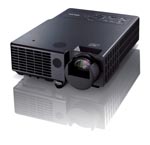
PLUS Vision TAXAN PS-121X
The PLUS Vision TAXAN PS-121X digital projector weighs 4 pounds and delivers 2,500 lumens of brightness. It offers a quick start feature with the image appearing only 18 seconds after the power is turned on. Auto keystone correction occurs three seconds after the first image is shown, correcting vertical distortion without any manual adjustment. When the presentation is over, the "unplug and go" feature allows the cooling fan to continue to operate, even when the cord is disconnected, so the projector cools down while the user packs up.
Optoma EP761
Optoma's EP761 multimedia projector has built-in audio with 3,200 lumens of brightness and a 2000:1 contrast ratio. The EP761 includes a fabrication that allows for easy lamp replacement. Weighing 6.3 pounds, the Optoma EP61 delivers the power and light intensity needed for today's demanding multimedia presentations.
Eiki LC-XT5
Eiki's LC-XT5 is 15,000 ANSI lumens and features a new a inorganic imaging engine optimized for extended use and 10 bit color video processing. It includes, vertical and horizontal lens shift and keystone correction, color management software, user logo, and built-in test patterns. It projects images up to 40 feet wide and contains a quick change lens installation system.
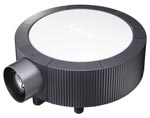
Sony VPL-FH300L
Sony's new 6,000-lumen VPL-FH300L projector, "The Turtle," is based on 3LCD and Sony's BrightEra imaging technologies and fills a niche between current business projectors and 4K large-venue systems. It delivers HD resolution of 2048 x 1080. Its round design includes large-diameter fans and high-flow cooling air ductwork that lets the projector run cool with decreased fan noise.
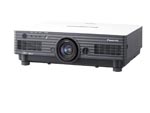
Panasonic PT-D4000U
The PT-D4000U packs 4,000 lumens, 1600:1 contrast ratio, and System Daylight View technology, producing crisp images even in brightly lit classrooms and meeting spaces. The addition of Panasonic's liquid-cooling system and newly developed AC lamp elevates performance stability and helps to minimize noise levels. The PT-D4000U provides lens-centered symmetrical design and new wireless remote control.

Digital Projection Lightning Pro Series
Lightning Pro Series projectors employ all of the new Pro Series II features, an intelligent lens mount, and 120Hz frame rate compatibility. The new Lightning Pro Series II projectors employ the latest in dark metal, 3-chip DLP technology, and include DPI's RapidRig staging and stacking hardware with integrated pitch, roll, and yaw adjustments.
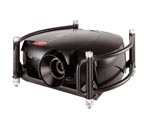
Barco RLM R6+
Barco's RLM R6+ offers the color quality of 3-chip DLP technology with a high-brightness light output. The RLM R6+ delivers SXGA+ resolution at 6,000 lumens. Through its flexible picture-in-picture capabilities, you can render your presentations interactive and energizing without having to buy extra peripherals. Barco's RLM R6+ comes equipped with an intelligent dual lamp system.
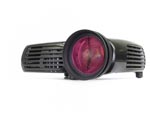
projectiondesign F10 WUXGA
projectiondesign's F10 Widescreen Ultra eXtended Graphics Array features 1920 x 1200 resolution, configuration flexibility, projectiondesign's RealColor color management suite, and a variety of lenses. Coupled with exceptional brightness and contrast, the new WUXGA technology delivers resolution that is 56 percent better than Super eXtended Graphics Array (SXGA+).
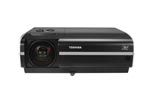
Toshiba TDP-EW25U
Toshiba's Digital Products Division released the TDP-EW25U projector. This new DLP BrilliantColor widescreen projector is a wireless network projector compatible with Microsoft Vista Ultimate's Meeting Space2 functionality for remote sharing of presentation files. The TDP-EW25U projector's extreme short projection technology can produce a 60-inch image from 2.4 feet away.
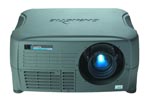
Christie HD3K And HD2Kc
The Christie HD3K and HD2Kc offer HD 3-chip DLP resolution with a 500W Xenon lamp, producing 2,900 and 2,300 ANSI lumens, respectively, with variable contrast ratio of 1600-2000:1 and a suite of high-quality lenses. The Christie HD2Kc model also includes optics specifically designed to create greater separation between the primary colors, providing a film-like experience.
Sharp PG-F320W DLP Projector
Sharp's first high brightness, DLP BrilliantColor projector with full 720p wide XGA resolution, the PG-F320W DLP projector provides enhanced colors and enriched images. The new projector also features built-in DVI-I/HDCP for a secure, virtually noise-free digital connection. RS-232C connectivity allows IT support departments to remotely check projector lamp life or provide operation support, and a built-in network connection with a RJ-45 LAN connector enables remote control.
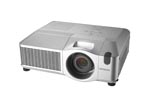
Hitachi CP-X807 3LCD Projector
Hitachi's CP-X807 3LCD projector offers crisp images at 5,000 ANSI lumens and a 1000:1 contrast ratio. The 15.8-pound CP-X807 displays images via a 1.2x manual zoom lens, with a throw distance of up to 42.4 feet. Using Hitachi's proprietary PJMan software, the CP-X807 can be remotely controlled and maintained through a LAN connection.

Mitsubishi FL7000U
The FL7000U HD 1080p projector features 5,000 lumens. Sports bars, restaurants, or hotel conference rooms as well as school auditoriums, corporate boardrooms, and operations centers will benefit from full high definition images for HD video, presentations, or computer data display. With its higher resolution (1920 x 1080) and its Split Screen feature, the FL7000U HD projector can keep your presentations on a single screen side-by-side with full size graphics that can showcase your entire story.
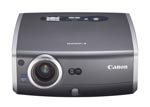
Canon REALis SX7
With SXGA+ resolution, Canon's REALiS SX7 multimedia projector features support of Adobe RGB and sRGB color space. Providing 4,000 ANSI lumen high-brightness and a contrast ratio of 1000:1 to help provide clear display of large images even in brightly lit environments, the REALiS SX7's images are brighter than earlier models. The REALiS SX7 is engineered to minimize operating noise, which maximizes concentration when used in a classroom environment.

NEC NP3151W
The NP3151W projector has a wide XGA resolution of 1280 x 800, which is perfectly matched to the widescreen laptops, and provides 30 percent more resolution to display more content. This model can also wirelessly display content from notebook computers without a cable. NEC designed this projector for business and conference rooms, but added HQV home theater video processing because corporate users are starting to add HD content and video to presentations to engage the audience.
